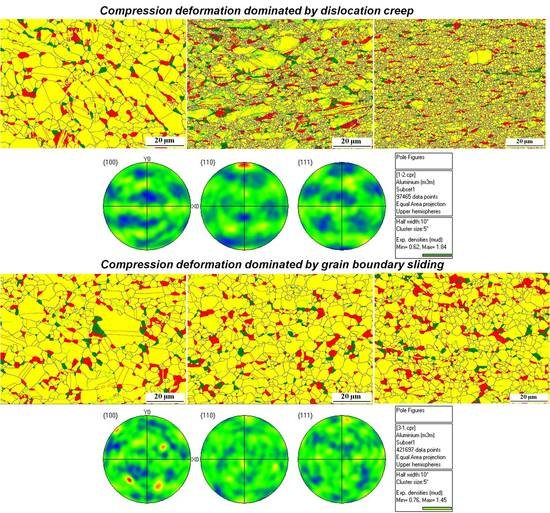Microstructure Evolution of a High Nb Containing TiAl Alloy with (α2 + γ) Microstructure during Elevated Temperature Deformation
Abstract
:1. Introduction
2. Materials and Methods
3. Results and Discussion
3.1. The Effect of Compression Parameters on Microstructure Evolution
3.2. The Effect of Strains on Microstructure Evolution
3.3. DRX of γ Grains
3.4. Texture of γ Grains
4. Conclusions
Author Contributions
Funding
Conflicts of Interest
References
- Shan, D.; Xu, W.; Han, X.; Huang, X. Study on isothermal precision forging process of rare earth intensifying magnesium alloy. Mater. Sci. Eng. B 2012, 177, 1698–1702. [Google Scholar] [CrossRef]
- Stark, A.; Rackel, M.; Tankoua, A.T.; Oehring, M.; Schell, N.; Lottermoser, L.; Schreyer, A.; Pyczak, F. In situ high-energy X-ray diffraction during hot-forming of a multiphase TiAl alloy. Metals 2015, 5, 2252–2265. [Google Scholar] [CrossRef]
- Clemens, H.; Mayer, S. Design, processing, microstructure, properties, and applications of advanced intermetallic TiAl alloys. Adv. Eng. Mater. 2013, 15, 191–215. [Google Scholar] [CrossRef]
- Kim, Y.W.; Kim, S.L. Advances in Gammalloy materials-processes-application technology: Successes, dilemmas, and future. JOM 2018, 70, 553–560. [Google Scholar] [CrossRef]
- Loria, E.A. Gamma titanium aluminides as prospective structural materials. Intermetallics 2000, 8, 1339–1345. [Google Scholar] [CrossRef]
- Wu, X. Review of alloy and process development of TiAl alloys. Intermetallics 2006, 14, 1114–1122. [Google Scholar] [CrossRef]
- Imayev, V.; Imayev, R.; Khismatullin, T.; Güther, V.; Beck, W.; Fecht, H.J. Superplastic behavior of Ti-43Al-7(Nb, Mo)-0.2B alloy in the cast+heat-treated condition. Scr. Mater. 2007, 57, 193–196. [Google Scholar] [CrossRef]
- Tetsui, T.; Shindo, K.; Kaji, S.; Kobayashi, S.; Takeyama, M. Fabrication of TiAl components by means of hot forging and machining. Intermetallics 2005, 13, 971–978. [Google Scholar] [CrossRef]
- Bézi, Z.; Krállics, G.; EI-Tahawy, M.; Pekker, P.; Gubicza, J. Processing of ultrafine-grained titanium with high strength and good ductility by a combination of multiple forging and rolling. Mater. Sci. Eng. A 2017, 688, 210–217. [Google Scholar] [CrossRef]
- Mamedov, A.; Ozturk, H.; Makas, T. Investigation of mechanical and microstructural properties of Ti-6Al-4V alloy depending on hot forging process parameters. Procedia Eng. 2017, 207, 2155–2160. [Google Scholar] [CrossRef]
- Cheng, L.; Li, J.; Xue, X.; Tang, B.; Kou, H.; Bouzy, E. Superplastic deformation mechanisms of high Nb containing TiAl alloy with (α2 + γ) microstructure. Intermetallics 2016, 75, 62–71. [Google Scholar] [CrossRef]
- Cheng, L.; Li, J.; Xue, X.; Tang, B.; Kou, H.; Perroud, O.; Bouzy, E. Effect of β/B2 phase on cavitation behavior during superplastic deformation of TiAl alloys. J. Alloys Compd. 2017, 693, 749–759. [Google Scholar] [CrossRef]
- Sun, Y.; Wan, Z.; Hu, L.; Ren, J. Characterization of hot processing parameters of powder metallurgy TiAl-based alloy based on the activation energy map and processing map. Mater. Des. 2015, 86, 922–932. [Google Scholar] [CrossRef]
- Zhang, D.; Li, H.; Liang, X.; Wei, Z.; Liu, Y. Microstructure characteristic for high temperature deformation of powder metallurgy Ti-47Al-2Cr-0.2Mo alloy. Mater. Des. 2014, 59, 415–420. [Google Scholar] [CrossRef]
- Godor, F.; Werner, R.; Lindemann, J.; Clemens, H.; Mayer, S. Characterization of the high temperature deformation behavior of two intermetallic TiAl-Mo alloys. Mater. Sci. Eng. A 2015, 648, 208–216. [Google Scholar] [CrossRef]
- Kong, F.; Cui, N.; Chen, Y.; Wang, X.; Xiong, N. Characterization of hot deformation behavior of as-forged TiAl alloy. Intermetallics 2014, 55, 66–72. [Google Scholar] [CrossRef]
- Schwaighofer, E.; Clemens, H.; Lindemann, J.; Stark, A.; Mayer, S. Hot-working behavior of an advanced intermetallic multi-phase γ-TiAl based alloy. Mater. Sci. Eng. A 2014, 614, 297–310. [Google Scholar] [CrossRef] [Green Version]
- Niu, H.; Kong, F.; Chen, Y.; Zhang, C. Low-temperature superplasticity of forged Ti-43Al-4Nb-2Mo-0.5B alloy. J. Alloys Compd. 2012, 543, 19–25. [Google Scholar] [CrossRef]
- Zhang, C.; Zhang, K. Superplasticity of a γ-TiAl alloy and its microstructure and cavity evolution in deformation. J. Alloys Compd. 2010, 492, 236–240. [Google Scholar] [CrossRef]
- Wang, Y.; Wang, J.; Yang, J. Superplastic behavior of a high-Cr TiAl alloy in its cast state. J. Alloys Compd. 2004, 364, 93–98. [Google Scholar] [CrossRef]
- Imayev, R.; Salishchev, G.; Senkov, O.; Imayev, V.; Shagiev, M.; Gabdullin, N.; Kuznetsov, A.; Froes, F. Low-temperature superplasticity of titanium aluminides. Mater. Sci. Eng. A 2001, 300, 263–277. [Google Scholar] [CrossRef]
- Imayev, R.; Shagiev, M.; Salishchev, G.; Imayev, V.; Valitov, V. Superplasticity and hot rolling of two-phase intermetallic alloy based on TiAl. Scr. Mater. 1996, 34, 985–991. [Google Scholar] [CrossRef]
- Chu, Y.; Li, J.; Zhao, F.; Tang, B.; Kou, H. Flow behavior and constitutive relationship for elevated temperature compressive deformation of a high Nb containing TiAl alloy with (α2 + γ) microstructure. Mater. Lett. 2018, 210, 58–61. [Google Scholar] [CrossRef]
- Chu, Y.; Li, J.; Zhao, F.; Tang, B.; Kou, H. Characterization of the elevated temperature compressive deformation behavior of high Nb containing TiAl alloys with two microstructures. Mater. Sci. Eng. A 2018, 725, 466–478. [Google Scholar] [CrossRef]
- Appel, F.; Paul, J.D.H.; Oehring, M. Gamma Titanium Aluminide Alloys: Science and Technology; Wiley-VCH: Weinheim, Germany, 2011. [Google Scholar]
- Humphreys, F.J.; Hatherly, M. Recrystallization and Related Annealing Phenomena, 2nd ed.; Elsevier: Amsterdam, The Netherlands, 2004. [Google Scholar]
- Zambaldi, C.; Zaefferer, S.; Wright, S.I. Characterization of order domains in γ-TiAl by orientation microscopy based on electron backscatter diffraction. J. Appl. Crystallogr. 2009, 42, 1092–1101. [Google Scholar] [CrossRef] [Green Version]
- Mingard, K.P.; Day, A.P.; Quested, P.N. Recent developments in two fundamental aspects of electron backscatter diffraction. IOP Conf. Ser. Mater. Sci. Eng. 2014, 55, 012011. [Google Scholar] [CrossRef] [Green Version]
- Li, J.; Liu, Y.; Wang, Y.; Liu, B.; He, Y. Dynamic recrystallization behavior of an as-cast TiAl alloy during hot compression. Mater. Charact. 2014, 97, 169–177. [Google Scholar] [CrossRef]
- Bartels, A.; Kestler, H.; Clemens, H. Deformation behavior of differently processed γ-titanium aluminides. Mater. Sci. Eng. A 2002, 329, 153–162. [Google Scholar] [CrossRef]
- Hasegawa, M.; Yamamoto, M.; Fukutomi, H. Formation mechanism of texture during dynamic recrystallization in γ-TiAl, nickel and copper examined by microstructure observation and grain boundary analysis based on local orientation measurements. Acta Mater. 2003, 51, 3939–3950. [Google Scholar] [CrossRef]
- Cheng, L.; Chang, H.; Tang, B.; Kou, H.; Li, J. Deformation and dynamic recrystallization behavior of a high Nb containing TiAl alloy. J. Alloys Compd. 2013, 552, 363–369. [Google Scholar] [CrossRef]
- Wang, Y.; Liu, Y.; Yang, G.; Li, J.; Liu, B.; Wang, J.; Li, H. Hot deformation behaviors of β phase containing Ti-43Al-4Nb-1.4W-based alloy. Mater. Sci. Eng. A 2013, 577, 210–217. [Google Scholar] [CrossRef]
- Wang, G.; Xu, L.; Tian, Y.; Zheng, Z.; Cui, Y.; Yang, R. Flow behavior and microstructure evolution of a P/M TiAl alloy during high temperature deformation. Mater. Sci. Eng. A 2011, 528, 6754–6763. [Google Scholar] [CrossRef]
- Wang, Y.; Shao, W.; Zhen, L.; Zhang, X. Microstructure evolution during dynamic recrystallization of hot deformed superalloy 718. Mater. Sci. Eng. A 2008, 486, 321–332. [Google Scholar] [CrossRef]
- Bartels, A.; Schillinger, W. Micromechanical mechanism of texture formation in γ-TiAl. Intermetallics 2001, 9, 883–889. [Google Scholar] [CrossRef]



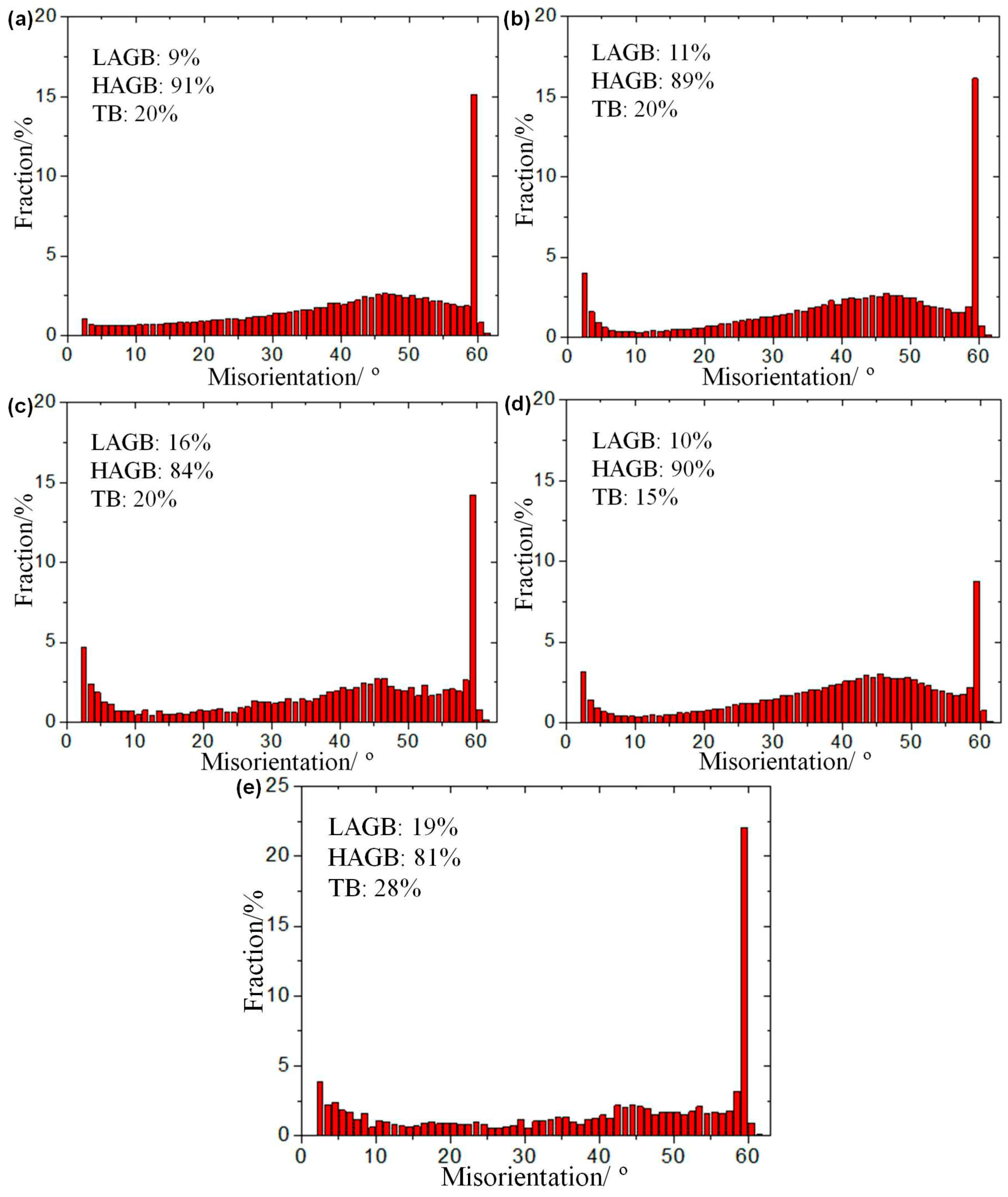
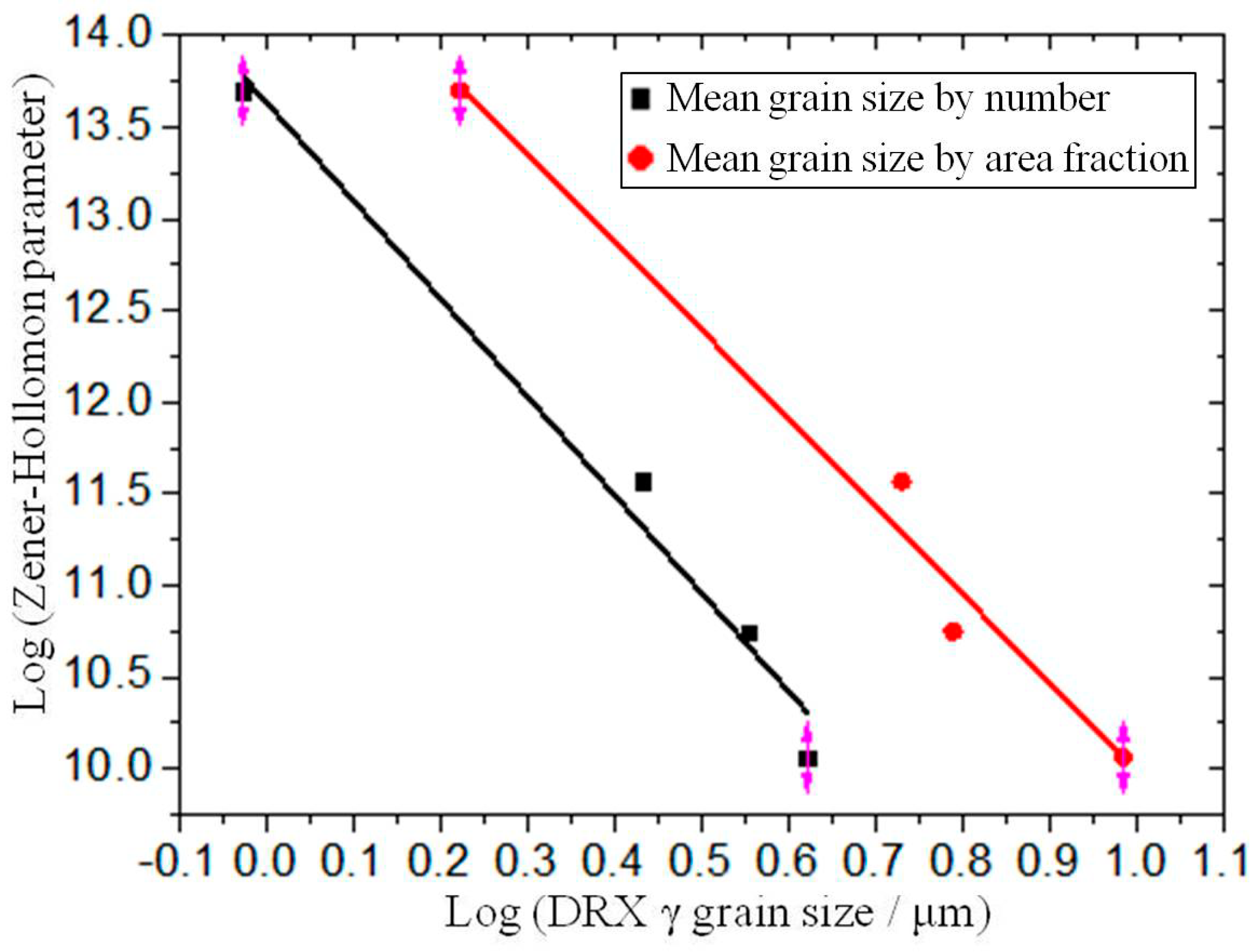

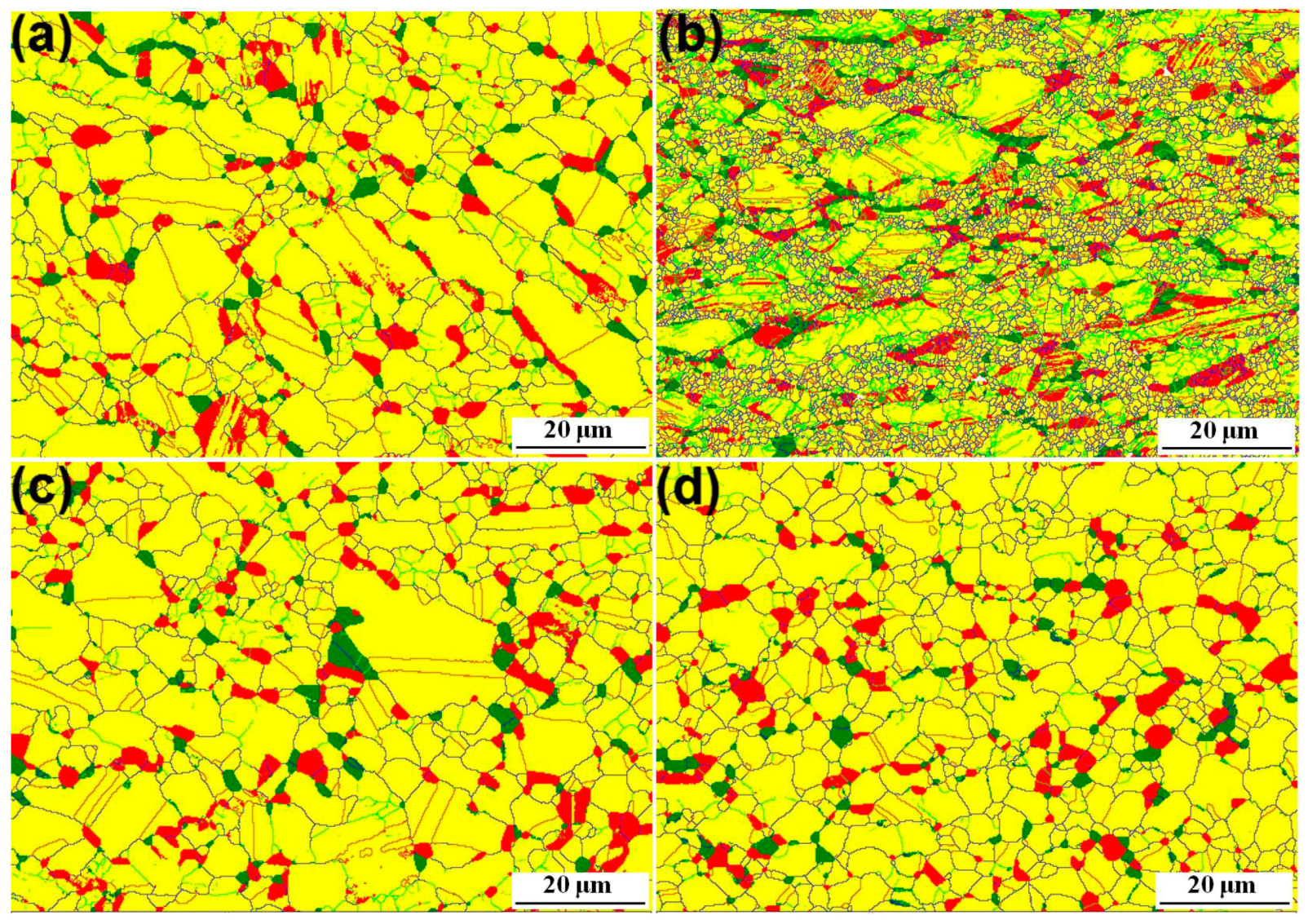



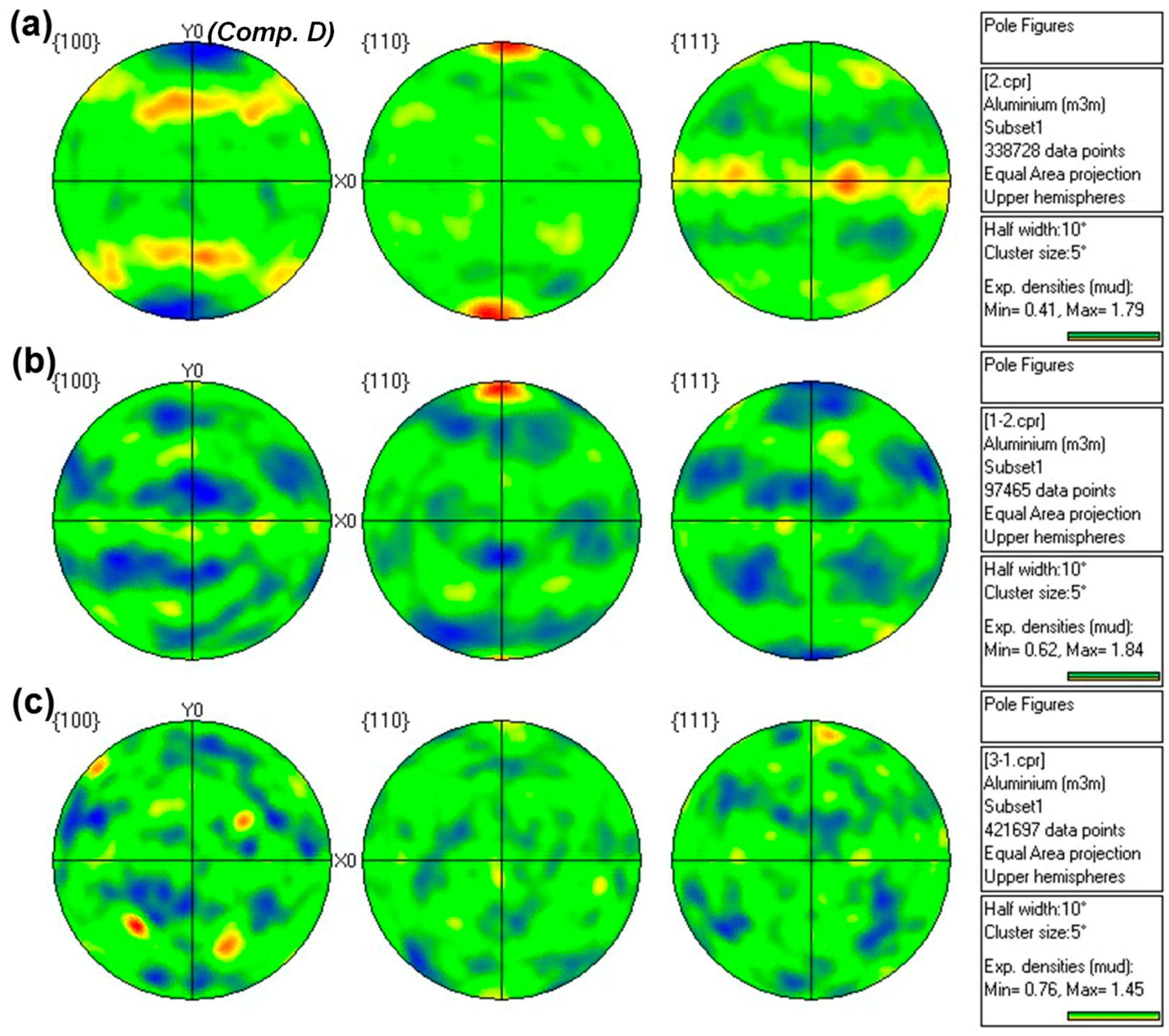
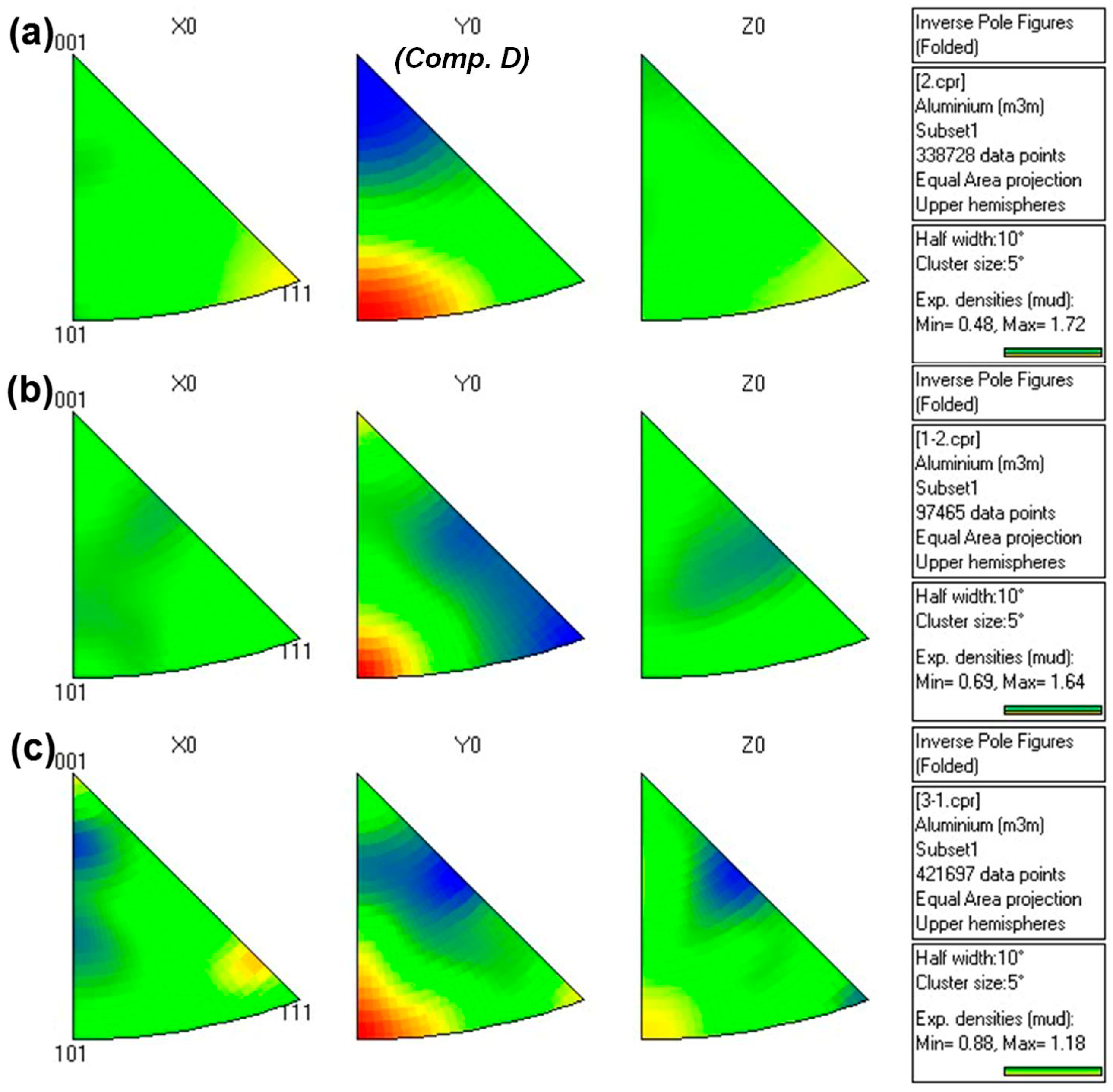
| Deformation Condition | Ln(Z) | Log(Z) |
|---|---|---|
| 1000 °C/10−2 s−1 | 31.5 | 13.7 |
| 1000 °C/5 × 10−4 s−1 | 26.6 | 11.6 |
| 1000 °C/10−4 s−1 | 24.7 | 10.7 |
| 1050 °C/10−4 s−1 | 23.2 | 10.1 |
© 2018 by the authors. Licensee MDPI, Basel, Switzerland. This article is an open access article distributed under the terms and conditions of the Creative Commons Attribution (CC BY) license (http://creativecommons.org/licenses/by/4.0/).
Share and Cite
Chu, Y.; Li, J.; Zhu, L.; Liu, Y.; Tang, B.; Kou, H. Microstructure Evolution of a High Nb Containing TiAl Alloy with (α2 + γ) Microstructure during Elevated Temperature Deformation. Metals 2018, 8, 916. https://doi.org/10.3390/met8110916
Chu Y, Li J, Zhu L, Liu Y, Tang B, Kou H. Microstructure Evolution of a High Nb Containing TiAl Alloy with (α2 + γ) Microstructure during Elevated Temperature Deformation. Metals. 2018; 8(11):916. https://doi.org/10.3390/met8110916
Chicago/Turabian StyleChu, Yudong, Jinshan Li, Lei Zhu, Yan Liu, Bin Tang, and Hongchao Kou. 2018. "Microstructure Evolution of a High Nb Containing TiAl Alloy with (α2 + γ) Microstructure during Elevated Temperature Deformation" Metals 8, no. 11: 916. https://doi.org/10.3390/met8110916




